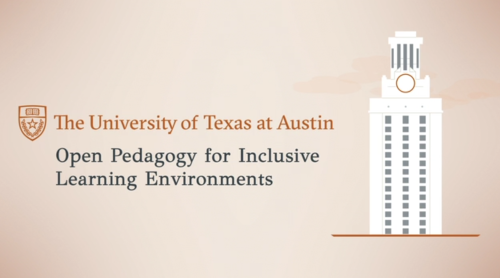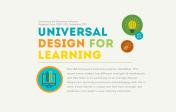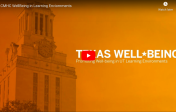Inclusive Teaching and Learning

Who's doing this at UT?
Visit the classroom of Dr. Jocelly Meiners to learn about using open pedagogy to promote community building and enhance student engagement. What are goals of this approach? How are learners impacted? Hear directly from students about their experiences in the course.
How Can I Do This?
Research shows that educational contexts frequently perpetuate barriers to learning and engagement despite instructors best efforts, which can hinder cognitive development and student well-being (Roksa, Kilgo, Trolian, Pascarella, Blaich, and Wise, 2017). Consider some of these strategies to help students feel welcome and engaged in the learning environments you create with them.
Intentionally design your course and curriculum with student wellbeing in mind.
How can you increase access and support for your students? Being proactive before the semester begins can reduce your time spent later making accommodations and resolving conflicts, which will enhance your teaching effectiveness.
- Think about your course and curriculum: which voices and perspectives are included? How are they represented in readings? Which ones are missing? Why?
- Provide multiple means of representation of course content. What are the different ways for students to access the course content? Lecture? Readings? Videos? Discussions?
- Create a variety of assignment types. Provide students with choices in how they complete an assignment or between two different assignments.
Review this Trauma Informed Pedagogy guide.
Clearly communicate expectations and offer support.
Research indicates that perceptions of what "high expectations" means often varies between faculty and student (Borghi, Mainardes, and Silva, 2016). Communicate early and often what high expectations means to you, and provide support to all students as they work towards those expectations.
- Establish ground rules for class participation and discussion. Ask for student input, and feel free to revisit (and revise) the rules during the semester as needed.
- Offer frequent formative assessment opportunities as "climate checks" to gauge student perceptions of the course and their progress.
- Learn More
Get to know your students.
Ask students questions about their experiences related to course content: What's your previous experience with this subject? What are your goals in this course? What are your fears about this course?
Reflect on your teaching practices.
Teaching, like learning, provides the promise of on-going development, if we let it. Take time to reflect on how your practices and perspectives have changed, and in which directions you want to see them move.
- Consider the intersecting aspects of students' lives to foster a sense of belonging among students.
- Mistakes are inevitable. How you respond to those mistakes can serve as an important model of humility for your students, and emphasize the ongoing nature of the learning process.
Why is This Important?
Considering students’ intersecting identities helps you connect your content to your learners, and also fosters a sense of belonging among students, cultivates empathy, and promotes resilience.
Foster a sense of belonging among students.
Research indicates a sense of belonging is positively associated with academic success and motivation (Freeman, Anderman, and Jensen, 2007). Students who feel they belong:
- are more likely to see the value of the required course work. (Verschelden, 2017, p. 58).
- have higher self-efficacy related to their estimates of their chances to succeed in the course (Verschelden, 2017, p. 58).
Cultural competency is a must-have skill in today’s workforce.
According to NACE's Job Outlook 2016 Survey, more than 80 percent of responding employers said they look for evidence that students have the skills to work well in teams.
- CEOs name cultural competence as one of the most critical leadership skills, according to a recent DDI survey.
- Cultural competency requires both an awareness of one’s own and others’ worldviews.
Transformative Teaching & Learning Symposium
What are you currently doing in your classroom to center community building and student voices? How does that definition get translated into practice in your approach to teaching & learning? Join us every April for an interactive series of sessions devoted to developing growth mindsets and building welcoming learning environments.

What is UDL?
Aiming for a more accessible learning environment? Want to cultivate more dynamic experiences amongst your learners? We invite you to add one strategy ("+1") from the Universal Design for Learning framework to your pedagogical practice.

Deeper Dive Instructional Guide: Inclusive Teaching and Learning
Explore more resources in this self-paced Canvas course.

Texas Well-being
With a Hogg Foundation Grant, the UT Counseling and Mental Health Center developed a set of resources on promoting well-being in learning environments.

